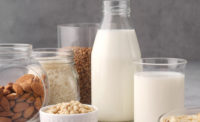Across the globe, 400 million children consume a meal at school daily. These meals provide more than just good nutrition; in many underdeveloped countries, school lunch is an incentive for children to attend school.
In 2021, an estimated 13 million children in the United States could be food-insecure, according to a USDairy.com infographic titled “COVID-19: Unveiling Its Impact on Food Insecurity.” School milk, including flavored milk, provides a critical safety net for these children.
School milk improves health
Sessions at IFT’s FIRST virtual conference outlined the status and importance of milk in school lunches, as well as how the COVID-19 pandemic has impacted delivery of school milk in the United States.
During the conference, Maretha Vermaak, R.D., from South Africa, reported on a 2020 study by the International Dairy Federation to determine the nutritional impact of school milk programs across 62 countries. School milk helps to improve child health and nutrition, promote local milk and encourage school attendance, the federation notes.
Regular consumption of milk and dairy products is associated with better growth, improved levels of micronutrients and enhanced cognitive performance in children. The United States initiated “school milk” in the 1940s to improve the nutrition of children following the war and the Great Depression. Japan started providing school milk in 1949, and now the average child in that country is 1 centimeter taller.
Most children across the globe receive 200 to 300 milliliters of milk, primarily as plain skim or semi-skim milk. Variations include yogurt, plain whole milk, flavored milk, lactose-reduced milk and long-shelf-life milk. Including flavored milk increases consumption and reduces waste in school milk programs, according to a study by the Milk Processor Education Program.
“The average flavored milk available in schools today has about 122 calories (only 25 more than white milk) and about 55% less added sugar than flavored milk 10 years ago,” Melissa Brunk, M.S., RDN, CLC, Colorado school wellness consultant, wrote in a 2019 Dairy Max blog post. “Studies have shown that flavored milk contributes only about 4% of added sugars to kid’s diets, and health and wellness authorities have noted that some added sugars can be included as part of healthy eating patterns to help increase consumption of nutrient-rich foods like dairy.”
India is the largest producer of milk in the world, according to Meenesh Shah, executive director of India’s National Dairy Development Board. Most Indian families have one to three animals, so milk is produced by the masses, rather than by mass production. Milk consumption has had a positive correlation with livelihood, nutrition and security of the country.
In India, children are served fortified and sweetened milk. Other options include sweet kheer (a pudding) and balamruthan (a mixture of wheat, split chickpea, milk power, oil and sugar).
Impact of COVID-19
Katie Bambacht, RDN, LDN, SNS, speaking at IFT’s FIRST, noted that currently 130 million children in the United States receive school meals, and more than 15 million children participate daily. Breakfast has become more popular because of flexible options that include breakfast in the classroom and various grab-and-go options.
The COVID-19 pandemic adversely affected school attendance, but schools were able to adapt by changing the distribution of school meals. Moreover, GenYouth raised more than $20 million to support the distribution of school meals to children.
Previously, most of the milk that accompanied these meals was in paperboard cartons, but during the pandemic-related attendance disruptions, milk was distributed in gallons and half-gallons. Meal-pattern flexibility waivers due to the COVID-19 pandemic allow schools to continue serving 1% flavored milk through the end of the 2022 school year.
In the United States, most children over the age of 3 are not consuming the recommended servings of dairy daily; for low-income children, school milk accounts for 77% of daily milk intake. Across the globe, school milk provides critical nutrition to vulnerable child populations, so it is vital to provide milk in formats and varieties that children enjoy.




